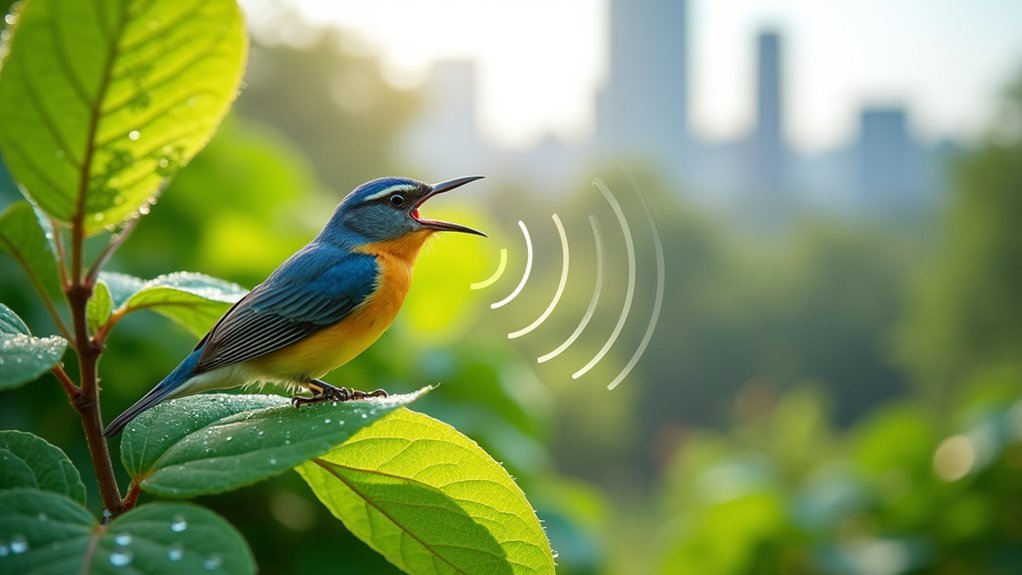The most effective methods to prevent urban bird roosting include installing physical barriers like spikes, netting, or wire systems on ledges and flat surfaces; modifying habitat by removing food sources, sealing entry points, and adding sloped caps to ledges; and using deterrent systems that combine visual elements (reflective tape, decoys) with sound devices. You’ll need regular maintenance to guarantee these solutions remain effective over time. Discover how strategic implementation of these approaches can transform your bird management results.
Physical Barriers: Strategic Installation For Maximum Effectiveness

When dealing with persistent urban bird roosting, physical barriers serve as your first line of defense against unwanted avian guests. Bird spikes create difficult landing surfaces on ledges where pest birds typically gather, effectively preventing birds from roosting in urban areas.
For larger spaces, bird netting provides an all-encompassing physical barrier that blocks access to balconies and gardens where birds might nest.
Consider bird wire systems with their spring-tension design when you need a less visible solution that still creates uncomfortable landing or nesting conditions.
For maximum effectiveness, combine these approaches with shock tracks discreetly installed along architectural features.
Remember that strategic installation is vital—place your deterrents where birds frequently land. Regular maintenance guarantees these effective deterrents continue to deter birds throughout the year.
Habitat Modification: Creating Bird-Unfriendly Environments
Beyond installing physical barriers, truly effective bird management requires intelligent habitat modification. You’ll need to assess your property for features that attract birds and systematically eliminate them.
Effective bird management means intelligently modifying habitats, not just installing barriers.
Begin by removing flat surfaces where birds prefer to perch—install sloped caps on ledges and modify eaves to create uncomfortable landing spots.
- Seal potential nesting sites by filling gaps in buildings, blocking entry points to attics, and covering vents with appropriate screens.
- Eliminate food sources by securing trash containers, promptly removing fallen fruits, and discouraging public feeding.
- Modify water features with moving water elements or install covers to prevent birds from drinking and bathing.
These habitat modification techniques complement physical bird control solutions like bird spikes and netting, creating extensive protection by making your property fundamentally less attractive to roosting birds.
Deterrent Systems: Sound And Visual Techniques That Work

Effective deterrent systems offer non-physical methods to discourage persistent urban birds from choosing your property as their home.
Sound deterrents that emit predator sounds or distress calls have proven highly effective in urban areas, creating an uncomfortable environment that birds naturally avoid.
You’ll find visual deterrents equally valuable in your bird control methods.
Install reflective tape, scare balloons, or plastic predator decoys around roosting hotspots.
Remember, birds quickly adapt to stationary objects, so regularly reposition these visual elements to maintain their effectiveness.
For best results, combine both sound and visual techniques in your strategy.
Studies confirm this multi-faceted approach yields the highest success rates for preventing roosting.
Frequently Asked Questions
How to Deter Birds From Roosting?
You’ll deter birds from roosting by installing spikes on ledges, hanging reflective tape, using sonic deterrents that emit predator calls, putting up bird netting, and designing spaces with sloped surfaces they can’t perch on.
What Deters Birds From Perching?
You’ll deter birds from perching with physical barriers like spikes or wires. Try visual deterrents such as reflective tape, install sonic devices that emit distress calls, or apply slippery surfaces where they typically land.
What Is the Most Effective Bird Deterrent?
Bird netting is your most effective deterrent, creating a physical barrier birds can’t penetrate. When you’re facing persistent roosting issues, you’ll find this solution provides complete exclusion compared to other methods.
Which Is the Best Method to Keep Birds From Roosting on Window Ledges?
To keep birds off your window ledges, installing bird spikes is most effective. They’re humane and create a physical barrier birds can’t land on. For aesthetic concerns, clear bird gel or wire systems work well too.
In Summary
Implementing the right mix of physical barriers, habitat alterations, and deterrent systems will greatly reduce unwanted bird roosting in your urban area. You’ll see best results when you’re consistent with your approach and adapt strategies seasonally. Remember, you’re not eliminating birds from the environment—you’re simply redirecting them to more appropriate locations. With these methods, you’ll maintain cleaner, healthier urban spaces while coexisting responsibly with urban wildlife.





Leave a Reply